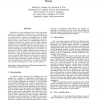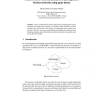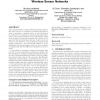1017 search results - page 119 / 204 » A Theory of QoS for Wireless |
CORR
2007
Springer
13 years 8 months ago
2007
Springer
Abstract—In wireless networks with random node distribution, the underlying point process model and the channel fading process are usually considered separately. A unified frame...
WOWMOM
2006
ACM
14 years 2 months ago
2006
ACM
Motivated by recent surfacing viruses that can spread over the air interfaces, in this paper, we investigate the potential disastrous threat of node compromise spreading in wirele...
EURONGI
2006
Springer
14 years 14 days ago
2006
Springer
This is a framework for resource allocation in a heterogeneous system composed of various access networks, for instance Third Generation wireless networks (3G) and WLAN, in the pre...
WISEC
2009
ACM
14 years 3 months ago
2009
ACM
Time synchronization in highly distributed wireless systems like sensor and ad hoc networks is extremely important in order to maintain a consistent notion of time throughout the ...
CN
2004
13 years 8 months ago
2004
Wireless Sensor Networks (WSN) are characterized by the dense deployment of sensor nodes that continuously observe physical phenomenon. Due to high density in the network topology...



